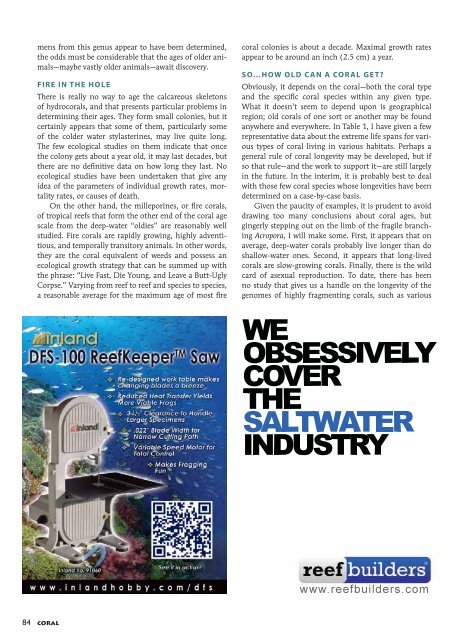Create successful ePaper yourself
Turn your PDF publications into a flip-book with our unique Google optimized e-Paper software.
mens from this genus appear to have been determined,<br />
the odds must be considerable that the ages of older animals—maybe<br />
vastly older animals—await discovery.<br />
FIRE IN THE HOLE<br />
There is really no way to age the calcareous skeletons<br />
of hydrocorals, and that presents particular problems in<br />
determining their ages. They form small colonies, but it<br />
certainly appears that some of them, particularly some<br />
of the colder water stylasterines, may live quite long.<br />
The few ecological studies on them indicate that once<br />
the colony gets about a year old, it may last decades, but<br />
there are no definitive data on how long they last. No<br />
ecological studies have been undertaken that give any<br />
idea of the parameters of individual growth rates, mortality<br />
rates, or causes of death.<br />
On the other hand, the milleporines, or fire corals,<br />
of tropical reefs that form the other end of the coral age<br />
scale from the deep-water “oldies” are reasonably well<br />
studied. Fire corals are rapidly growing, highly adventitious,<br />
and temporally transitory animals. In other words,<br />
they are the coral equivalent of weeds and possess an<br />
ecological growth strategy that can be summed up with<br />
the phrase: “Live Fast, Die Young, and Leave a Butt-Ugly<br />
Corpse.” Varying from reef to reef and species to species,<br />
a reasonable average for the maximum age of most fire<br />
coral colonies is about a decade. Maximal growth rates<br />
appear to be around an inch (2.5 cm) a year.<br />
SO…HOW OLD CAN A CORAL GET?<br />
Obviously, it depends on the coral—both the coral type<br />
and the specific coral species within any given type.<br />
What it doesn’t seem to depend upon is geographical<br />
region; old corals of one sort or another may be found<br />
anywhere and everywhere. In Table 1, I have given a few<br />
representative data about the extreme life spans for various<br />
types of coral living in various habitats. Perhaps a<br />
general rule of coral longevity may be developed, but if<br />
so that rule—and the work to support it—are still largely<br />
in the future. In the interim, it is probably best to deal<br />
with those few coral species whose longevities have been<br />
determined on a case-by-case basis.<br />
Given the paucity of examples, it is prudent to avoid<br />
drawing too many conclusions about coral ages, but<br />
gingerly stepping out on the limb of the fragile branching<br />
Acropora, I will make some. First, it appears that on<br />
average, deep-water corals probably live longer than do<br />
shallow-water ones. Second, it appears that long-lived<br />
corals are slow-growing corals. Finally, there is the wild<br />
card of asexual reproduction. To date, there has been<br />
no study that gives us a handle on the longevity of the<br />
genomes of highly fragmenting corals, such as various<br />
84 CORAL

















